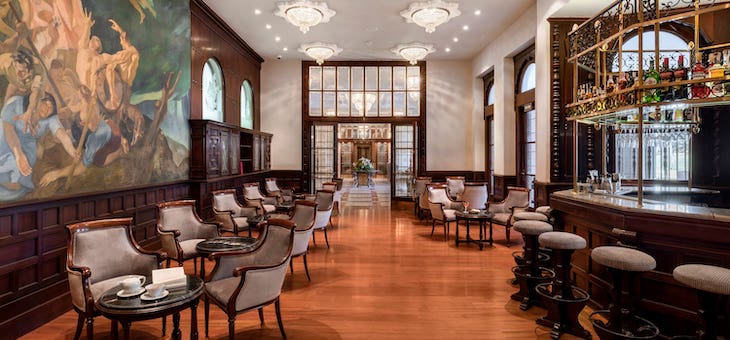“The Canary Islands? That’s a bit mass market for you, isn’t it?” sniffed my millennial hairdresser when I told her where I was going on holiday.
She had a point. As a pale-skinned redhead, I respond badly to heat. Lying on a beach in the subtropics doesn’t suit me. I’d much rather play safe by walking in a shady forest or visiting an art gallery.
But in the sodden depths of a British winter, an invitation to explore the Santa Catalina, A Royal Hideaway Hotel, in Las Palmas, was just the spark I needed to put my prejudices on hold.
I headed out only a few weeks before the pandemic brought travel to a standstill. An entire season has passed, but now the hotel has reopened its doors to visitors, and in a world filled with so much uncertainty, it’s historic walls have even more reassuring appeal.
To join Barcelo Group’s Royal Hideaway portfolio, a resort must be part of the ‘living history’ of its location and offer a serious slice of cultural heritage.
Following a newspaper announcement, a consortium of Canary Islands-based British businessmen launched a Spanish resort, which over subsequent decades, was visited by luminaries from prime minister Winston Churchill to operatic diva Maria Callas and Hollywood film star Gregory Peck.
But in the 1970s, Gran Canaria’s tourism development shifted to the golden beaches at the southern tip of the island. The Santa Catalina, overlooking the busy harbour of Las Palmas in the wetter and cooler north, was suddenly the wrong product in the wrong place.
Decades later, new owners Barcelo are confident the original allure can be resurrected and have invested €13.8m in Santa Catalina’s second major refit. The original British building was remodelled in 1946 by Miguel Martin-Fernandez de la Torre, brother of the modernist painter Nestor. When Nestor died unexpectedly, a second artist, Jesus Arencibia, was brought in to take his place. He created the daring anti-Franco protest mural, Procession of Death, which still adorns the wall of the 1940s British-style Carabela Bar today.
Strict laws governed the renovation of the listed building, and these extended to the protection of original artworks, artefacts and interiors. My sun-shaded junior suite was filled with heavy, dark wood in the Hispanic style, and gave me exclusive access to a vast, stone terrace above the main entrance.
Las Palmas, the ninth largest city in Spain, isn’t short of dining options. But now the Padrón brothers, the only Michelin-starred chefs to specialise in Canary Islands cuisine, are bringing the heavy artillery. At Poemas, their new restaurant at the Santa Catalina, I enjoyed an intricate seven-course tasting menu weighted towards the local seafood, and served with wines made from the distinctive malvasia and listan negro grapes, intriguing varieties which pre-date the 19th-century phylloxera epidemic that ravaged continental Europe.
The poolside Camarote Restaurant is more relaxed, serving beautifully presented Mediterranean cuisine. The 1890 La Bodeguita tapas bar is the most laid-back dining area. But having said that, this really isn’t hairy toes territory, or a resort that’s – apart from essential facilities for very small children – particularly geared to families. Smart-casual dressing is the rule and when night falls, it’s time to honour the hotel’s fabulous heritage with some serious international glamour.
There’s plenty to do here. “We have every season in one day,” observed Guillermo Bernal, of Gran Canaria Sightseeing, as we headed out along twisty roads around spectacular ravines to visit the ancient laurel forest of Los Tilos De Moya. It’s all to do with micro-climates: when trade winds from the Americas meet the mountains, they dump their moisture, creating the cloud forests and tinkling streams of the north, with their unique island flora and fauna.
At Finca La Laja, in the Agaete Valley, we ate cake and drank award-winning sweet wine at the EU’s only coffee plantation. The 200-year-old estate has been in the Lugo-Jorge family for generations, and their ingenious mom-and-pop tourism operation has created a self-financing museum of traditional agricultural practices in a landscape they love.
The day’s surprises ended with a visit to the Cueva Pintada museum at Galdar to see the cave paintings. A vast, covered complex in the centre of town is dedicated to the life and remains of Gran Canaria’s indigenous inhabitants.
Their story is a startling one: DNA samples suggest they were of North African descent, possibly relocated to the remote Canary Islands by the Romans in an offer they couldn’t refuse. In the 14th century, these indigenous people – known as Guanches – were conquered by the Spanish who obliterated their culture in what proved to be a dress rehearsal for the later invasion of Mexico.
Yet the Spanish, in turn, created something of note in Las Palmas – the first Renaissance-style planned city outside continental Europe. And the British, in the 19th century, developed both the port and the garden city area in which Santa Catalina is located. It’s a beautiful spot. Let’s hope this stunning hotel has a second chance at earning the recognition it deserves.
How to plan your trip
Rooms at the Santa Catalina start from €108/$175 with breakfast. Visit barcelo.com

